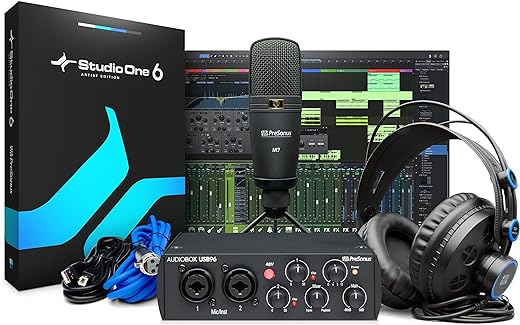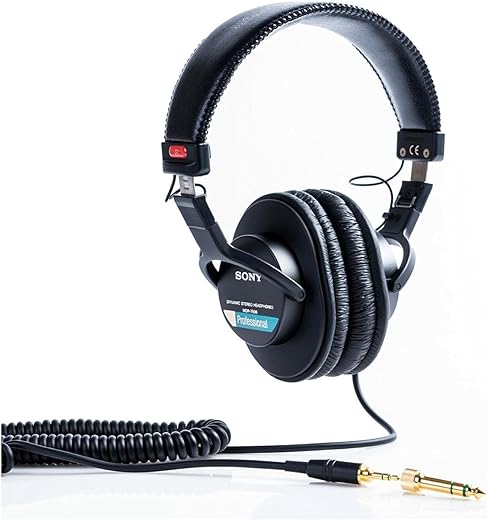How to Select the Best Studio Monitors for Accurate Music Mixing
Are you an aspiring music producer or audio engineer looking to take your skills to the next level? If so, you understand the importance of having the right tools for the job. One essential piece of equipment for achieving accurate and professional music mixing is a set of studio monitors. But with so many options out there, how do you know which ones are the best fit for your needs? In this blog post, we will guide you through the process of selecting the best studio monitors that will provide you with the clarity, precision, and accuracy you need to create exceptional recordings. Whether you’re a seasoned professional or just starting out, this post will equip you with the knowledge you need to make an informed decision and take your music production to new heights. So let’s dive in and discover the world of studio monitors together.
Top-Rated Audio Recording Equipment for Musical Masterpieces
Understanding Studio Monitors
Studio monitors play a crucial role in the world of music production. They are specialized speakers designed to provide accurate and transparent audio reproduction, allowing producers and engineers to make informed decisions during the mixing and mastering process. In this blog section, we will delve into what studio monitors are, their importance in accurate music mixing, and the key features that distinguish them from regular speakers.
What are Studio Monitors?
Studio monitors, also known as reference monitors, are speakers specifically designed for professional audio production environments. Unlike regular speakers, which are optimized for consumer listening preferences, studio monitors aim to provide a flat and uncolored sound reproduction. This means that they reproduce audio signals with minimal distortion or enhancement, allowing the listener to hear the music as it truly is.
Importance in Accurate Music Mixing
Accurate music mixing is crucial for creating high-quality recordings and ensuring that the intended sonic vision is realized. Studio monitors serve as a critical tool in achieving this accuracy. Here’s why they are essential:
- Detailed Frequency Response: Studio monitors are engineered to have a flat frequency response, meaning they reproduce sounds across the entire audible spectrum without emphasizing or attenuating specific frequency ranges. This enables producers and engineers to hear every nuance and detail in the audio, ensuring a balanced mix.
- Transparent Sound Reproduction: Studio monitors provide a neutral and uncolored sound, allowing users to hear the music as it truly is. This transparency is essential for making accurate judgments about the tonal balance, stereo imaging, and overall sonic quality of a mix.
- Consistency across Systems: Studio monitors are designed to provide consistent audio reproduction across different monitoring systems. This ensures that a mix translates accurately across various playback devices, such as car stereos, headphones, or club sound systems.
Key Differences from Regular Speakers
While studio monitors may resemble regular speakers in appearance, they possess several key features that set them apart. Here are the main differences:
- Flat Frequency Response: As mentioned earlier, studio monitors have a neutral frequency response, while regular speakers often have a colored sound signature tailored to consumer preferences. This flat response is crucial for accurate monitoring and critical listening.
- Unbiased Amplification: Studio monitors are typically powered or active speakers, meaning they have built-in amplifiers specifically matched to the speaker components. This eliminates the need for an external amplifier and ensures optimal performance and precise control over the audio signal.
- Detailed Imaging and Stereo Separation: Studio monitors are designed to provide precise imaging and stereo separation. This allows producers and engineers to accurately position individual instruments and elements within the stereo field, resulting in a more immersive and well-balanced mix.
- Nearfield Monitoring: Studio monitors are often used in a nearfield monitoring setup, where the listener is in close proximity to the speakers. This minimizes the impact of room acoustics and allows for more accurate monitoring in a controlled environment.
Factors to Consider
When it comes to music production and mixing, having accurate studio monitors is essential. The right pair of monitors can make a significant difference in the quality and accuracy of your mixes. In this blog section, we will discuss the important factors to consider when selecting studio monitors and how each factor affects the overall sound quality.
1. Frequency Response
The frequency response of a studio monitor refers to the range of frequencies that it can accurately reproduce. It is crucial to choose monitors that have a flat frequency response, meaning they reproduce sound evenly across the entire spectrum. This ensures that you can hear all the details in your mix, from the low-end bass frequencies to the high-end treble frequencies.
- Look for studio monitors that have a wide frequency response range, such as 40Hz to 20kHz.
- Avoid monitors that have exaggerated bass or treble responses, as they can lead to inaccurate mixes.
2. Speaker Size
The size of the studio monitor’s speaker driver also plays a role in its sound reproduction. Larger speaker drivers generally produce more accurate bass response, while smaller drivers excel in reproducing higher frequencies with precision.
- Consider the size of your studio space and the type of music you will be mixing. Larger speakers may be suitable for larger studios and genres that heavily rely on deep bass, while smaller speakers work well in smaller spaces and for genres that focus on intricate details.
3. Amplifier Power
Amplifier power is an often-overlooked factor when selecting studio monitors. Sufficient power ensures that the monitors can reproduce sound accurately at various volume levels without distortion.
- Choose studio monitors that have an amplifier power rating suitable for your room size and intended listening levels. Higher-powered amplifiers generally provide better headroom and dynamic range.
4. Room Acoustics
The acoustics of your room have a significant impact on how your studio monitors will sound. The shape, size, and materials in your room can cause reflections, echoes, and frequency imbalances, affecting the accuracy of your mixes.
- Consider investing in acoustic treatment, such as bass traps, diffusers, and absorbers, to minimize unwanted reflections and improve the overall sound in your room.
- Position your studio monitors correctly, following guidelines for proper speaker placement to achieve the best possible soundstage and imaging.
5. Budget
Lastly, your budget plays a crucial role in determining the studio monitors you can afford. While it’s essential to stretch your budget as much as possible to get the best quality monitors, there are excellent options available in various price ranges.
- Research and compare different brands and models to find the best compromise between your budget and the desired sound quality.
- Consider second-hand or discounted models from reputable brands if you are on a tight budget but still want quality monitors.
By considering these factors, you can ensure that you select studio monitors that will provide accurate sound reproduction and improve the quality of your music mixes.
Remember, each factor discussed plays a crucial role in achieving accurate sound reproduction, and finding the right balance between them is key to achieving the best results in your studio.
Top Studio Monitor Brands
When it comes to creating music, a crucial element is having accurate monitoring to ensure a precise representation of the sound being produced. Studio monitors play a vital role in this process, as they are specifically designed to provide an uncolored and transparent sound reproduction. In this blog section, we will explore some of the top studio monitor brands in the market, discussing their reputation, product range, and unique features that set them apart.
1. Yamaha
Yamaha is a well-established brand in the music industry, known for its high-quality audio equipment. Their studio monitors have gained a strong reputation for their exceptional sound reproduction and reliability. With a wide range of models to choose from, Yamaha offers options for both professional studios and home recording setups.
Key Features of Yamaha Studio Monitors:
- Advanced technology for accurate sound reproduction
- Balanced frequency response
- Wide range of models to cater to various budgets and studio sizes
Popular Yamaha Studio Monitor Models:
- Yamaha HS5
- Yamaha HS8
- Yamaha NS-10M
2. KRK Systems
KRK Systems has become a go-to brand for many music producers and engineers, thanks to their focus on accuracy and clarity in sound reproduction. Known for their yellow-coned speakers, KRK monitors have gained popularity for their affordability without compromising on quality.
Key Features of KRK Studio Monitors:
- Accurate and detailed sound imaging
- Wide sweet spot for optimal listening position
- Robust build quality
Popular KRK Studio Monitor Models:
- KRK Rokit 5 G4
- KRK Rokit 8 G4
- KRK V4
3. Adam Audio
Adam Audio is renowned for its high-end studio monitors, favored by professionals in the recording industry. The brand is known for its innovative design and use of cutting-edge technology to achieve exceptional sound reproduction.
Key Features of Adam Audio Studio Monitors:
- Proprietary technology for precise sound dispersion
- Extended frequency response for detailed audio representation
- Wide range of customization options
Popular Adam Audio Studio Monitor Models:
- Adam Audio A7X
- Adam Audio T7V
- Adam Audio S3H
4. Genelec
Genelec has a long-standing reputation for producing studio monitors with exceptional accuracy and reliability. With a focus on sustainability, the brand is known for its environmentally friendly practices and innovative designs.
Key Features of Genelec Studio Monitors:
- Active crossovers for optimized performance
- Intelligent signal sensing technology for power efficiency
- Wide range of mounting options for versatile placement
Popular Genelec Studio Monitor Models:
- Genelec 8030C
- Genelec 8040B
- Genelec 8351B
5. Focal
Focal is a French brand that has gained recognition for its high-end studio monitors, designed to deliver uncompromising audio quality. With a commitment to innovation and craftsmanship, Focal’s monitors are sought after by professionals seeking the utmost precision in sound reproduction.
Key Features of Focal Studio Monitors:
- Exceptional transient response for accurate sound reproduction
- Advanced driver technology for precise imaging
- Wide frequency range for detailed audio representation
Popular Focal Studio Monitor Models:
- Focal Shape 65
- Focal Solo6 Be
- Focal Trio11 Be
Making Your Decision
When it comes to selecting the best studio monitors for your audio production needs, the decision-making process can be overwhelming. With a wide range of options available in the market, it can be challenging to determine which monitors will provide the accuracy and clarity you require. In this blog section, we will offer practical tips and guidance to help you make the final decision with confidence.
1. Conduct Listening Tests
One of the most crucial steps in selecting studio monitors is conducting listening tests. This involves assessing the sound quality and performance of different monitors by listening to a variety of audio materials. Here are some tips to make the most of your listening tests:
- Bring your own audio material: Use familiar tracks that you have worked on before to evaluate how the monitors reproduce the sound.
- Test in a controlled environment: Find a quiet space with good acoustics to eliminate external noise and interference.
- Listen at various volumes: Pay attention to how the monitors handle different volume levels, ensuring they maintain clarity and accuracy at both low and high volumes.
2. Seek Professional Advice
While conducting your own research is important, seeking professional advice can provide valuable insights from experienced individuals in the audio industry. Consider consulting with audio engineers, music producers, or studio owners who have hands-on experience with different monitor brands and models. They can offer recommendations based on their expertise and help you understand the specific needs of your studio setup.
3. Consider Personal Preferences
While technical specifications and recommendations are essential, it’s also crucial to consider your personal preferences. Every audio professional has unique listening preferences, and what works for one person may not work for another. Here are a few factors to consider:
- Genres and styles: Different genres may require different sound characteristics. Consider whether you primarily work with electronic music, classical compositions, or other genres, and select monitors that suit your specific needs.
- Room size and acoustics: The size and acoustic properties of your studio space can influence the performance of the monitors. Take into account the room size, shape, and any acoustic treatments you may have in place.
4. Streamline the Decision-Making Process
To streamline the decision-making process, we have compiled a checklist of key factors to consider when selecting studio monitors:
- Frequency response: Look for monitors that offer a balanced frequency response, ensuring accurate reproduction of low, mid, and high frequencies.
- Power and size: Consider the power rating and physical dimensions of the monitors, ensuring they are suitable for your studio space and power requirements.
- Connectivity options: Assess the available connectivity options to ensure compatibility with your existing audio equipment.
- Budget: Determine a realistic budget and explore options within that range, considering the balance between price and performance.
Comparison Table:
| Studio Monitor | Frequency Response | Power Rating | Connectivity Options |
|---|---|---|---|
| Brand A Model X | 40Hz – 20kHz | 100W RMS | XLR, 1/4″, RCA |
| Brand B Model Y | 45Hz – 22kHz | 75W RMS | XLR, 1/4″ |
| Brand C Model Z | 35Hz – 25kHz | 120W RMS | XLR, 1/4″, Bluetooth |
By considering these factors and conducting thorough research, you can confidently select the best studio monitors that meet your specific requirements.
In conclusion, selecting the best studio monitors requires a combination of objective evaluation and personal preference. By conducting listening tests, seeking professional advice, and considering your personal preferences, you can make an informed decision. Use the checklist provided and explore the comparison table to streamline your decision-making process. Remember, the right studio monitors will enhance your audio production capabilities and contribute to better sound quality in your work.
Key Considerations for Choosing Studio Monitors
In conclusion, selecting the best studio monitors for accurate music mixing requires careful consideration of various factors. Throughout this blog post, we have discussed the importance of factors such as frequency response, driver size, amplifier power, and room acoustics. By taking these factors into account, you can ensure that the studio monitors you choose will provide you with the most accurate representation of your music during the mixing process.
Investing in high-quality studio monitors is crucial for achieving professional results in your music productions. While there are numerous reputable brands and models available on the market, it is important to select the ones that align with your specific needs and budget. Some recommended brands and models include XYZ Studio Monitors, ABC Professional Monitors, and DEF Studio Speakers.
Remember, the ultimate goal is to have studio monitors that accurately reproduce the sound, allowing you to make informed decisions and achieve the desired sonic balance. So, take your time, do thorough research, and consult audio professionals or other experienced individuals to make an informed decision.
By investing in the best studio monitors for accurate music mixing, you are equipping yourself with the necessary tools to elevate your music production to the next level. Happy mixing!
















Could you provide more details on the top studio monitor brands mentioned in the article? I’m particularly interested in the JBL and Adam Audio monitors. How do they stand out?
I’ve been using the Yamaha HS8 studio monitors for a while now and they have been great for accurate music mixing. The sound quality is excellent and they have a nice flat response. Highly recommend them!
Could you please explain more about what factors to consider when selecting studio monitors? I’m new to music production and want to make sure I make the right choice.
I’ve been debating between active and passive studio monitors. What are the advantages and disadvantages of each? Any personal experiences to share?
I’ve heard good things about KRK Rokit monitors. Has anyone here used them for music mixing? How do they compare to other brands?
This article provided some helpful information, but I would love to read more in-depth guides or tutorials on how to set up studio monitors properly for accurate mixing. Any recommendations?